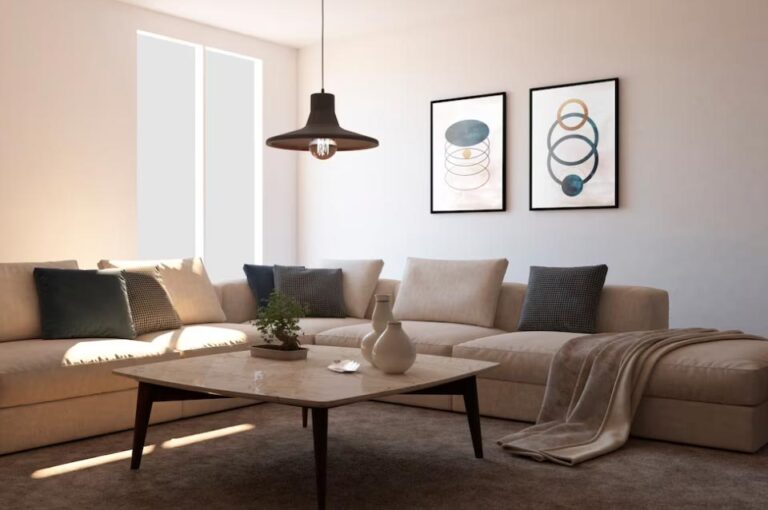In today’s fast-paced world, productivity is a prized asset. Whether working from an individual or shared office, or pursuing creative endeavors, the design of an interior space plays a pivotal role in determining your productivity levels. A well-thought-out interior design can make a significant difference in how efficiently and effectively people work.
The Impact of Interior Design on Productivity
Before delving into specific design elements, it’s crucial to understand how interior design can influence productivity. A well-designed space can reduce stress, boost motivation, and improve overall well-being. The layout, colors, lighting, and furniture choices all have an impact on how you feel and perform in a given space.
When designing for productivity, consider factors like natural light, comfort, and organization. A balanced, functional design can promote focus, creativity, and a sense of accomplishment.
Ergonomic Workspaces and Furniture Selection
Ergonomics is a key consideration when designing an interior space for productivity. Your workspace and the furniture you use should promote good posture and comfort. An ergonomic chair, an adjustable desk, and appropriate monitor positioning can prevent physical discomfort and fatigue, allowing you to work more efficiently for longer periods.
Additionally, it’s essential to consider the layout of your workspace. Ensure that the most frequently used items and tools are within easy reach to minimize unnecessary movements and distractions.
Lighting Strategies for Increased Productivity
Lighting is a critical aspect of interior design, and it can significantly impact your productivity. Natural light is ideal, as it promotes alertness and a positive mood. Position your workspace near windows if possible. However, when natural light is limited, artificial lighting becomes crucial.
Invest in task lighting that illuminates your work area without causing glare on screens. A well-lit room with appropriate lighting can reduce eye strain and help maintain focus throughout the day.
Implementing Rendering Tools
Incorporating 3D rendering services into these interior design processes can be a game-changer. 3D rendering allows you to visualize your interior space with incredible detail and realism before any construction or renovation work begins. This technology enables you to experiment with different design elements, such as lighting fixtures, furniture placement, and color schemes, in a virtual environment. By doing so, you can fine-tune your design to maximize productivity and aesthetic appeal.
3D rendering services also facilitate collaboration with interior designers and architects. They provide a common visual language for all parties involved, ensuring that everyone has a clear understanding of the design objectives. This can lead to more efficient decision-making and a smoother design process.
Color Psychology in Interior Design
Color has a profound psychological impact and can influence your mood and productivity. Different colors evoke various emotions and behaviors. For instance, blue is associated with calm and concentration, while yellow can enhance creativity and positivity.
Consider the type of work you do and the atmosphere you want to create when choosing colors for your interior space. A well-balanced color scheme can help set the right tone for your productivity.
Creating a Clutter-Free and Organized Environment
Clutter is the enemy of productivity. An organized and clutter-free workspace can help you stay focused and efficient. Invest in storage solutions that keep your items neatly organized, and declutter regularly to maintain a clean and inspiring environment.
An organized space reduces mental stress and helps you find what you need quickly, eliminating time wasted searching for misplaced items.
Incorporating Natural Elements for Well-Being
Bringing nature indoors can have a positive impact on your well-being and productivity. Houseplants not only purify the air but also add a touch of nature to your space, creating a more inviting and relaxing atmosphere.
Natural materials, such as wood and stone, can also be incorporated into your design, providing a sense of connection to the natural world. These elements can have a calming effect and promote a sense of well-being.
Acoustic Solutions for Noise Reduction
Noise can be a significant distraction in any workspace. Whether it’s the hum of appliances, street noise, or the chatter of coworkers, unwanted sounds can disrupt your focus.
Invest in noise-cancelling headphones or consider acoustic panels to reduce unwanted noise. A quieter environment fosters concentration and productivity, especially in open-office settings.
Personalization and Motivational Decor
Personalizing your interior space with decor that resonates with you can be a powerful motivator. Inspirational quotes, artwork, or family photos can provide a personal touch that keeps you motivated and engaged with your work.
Choose decor that reflects your goals and aspirations, creating a positive atmosphere that reminds you of what you’re working towards.
Technology Integration for Efficiency
In today’s digital age, technology plays a central role in our work lives. Ensure that your interior design accommodates your technological needs. Cable management, charging stations, and easy access to power outlets are all essential elements of a tech-friendly workspace.
Consider integrating smart home technology to control lighting, climate, and security with ease, further enhancing your efficiency and comfort.
Flexible and Adaptable Work Environments
Finally, flexibility is key to creating an interior space that enhances productivity. Your needs and work habits may change over time, so your design should be adaptable.
Invest in modular furniture, adjustable shelving, and movable partitions that allow you to reconfigure your space as needed. This adaptability ensures that your workspace remains conducive to productivity as your requirements evolve.
Conclusion
The design of your interior space can have a profound impact on your productivity. By considering ergonomic principles, lighting strategies, color psychology, organization, and the integration of technology, you can create a workspace that not only enhances your efficiency but also promotes your overall well-being. Additionally, incorporating elements of nature, reducing noise, personalization, and flexibility can further contribute to a productive and inspiring environment. Whether you’re working from home or in a corporate setting, a well-designed interior space can make a significant difference in your daily output and satisfaction.

0 Comments